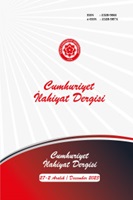Siyer İlmi Açısından Sahâbe Nesli Ṣaḥîfelerinin Oluşum Süreci ve Mahiyeti
The Formation Process and Nature of Sirah's Companions Generation Codexes
Author(s): Yunus AkyürekSubject(s): History of Islam, Sociology of Religion, History of Religion
Published by: Cumhuriyet Üniversitesi İlahyat Fakültesi
Keywords: Sirah; al-Maghāzî; Codex; Kitāb; Version;
Summary/Abstract: Codex is a concept known and widely used in Arab society since the Jahiliyyah period. It can be said that the Muslims did not need to use codex except for revelation during the Meccan period. However, this situation gained great momentum with the establishment of a city-state in Medina, and the Prophet dictated many writings to his scribes on religious, political, administrative, diplomatic, social and economic life. It is known that the Companions generation, independently of these, kept notes on the Prophet's ghazwas, expeditions, and his sīrah in general, either during his lifetime or after his death. Some of the Companions made use of their students and slaves for recording. Sometimes a student from the generation of the tābiʿīn recorded the narrations he had heard from one or more of the Companions, thus producing a codex that accurately reflects the scholarly accumulation of the Companions. Some of the Codices deal with various topics such as faith, ethics, fiqh, and the parts of fiqh other than worship, while some codices concentrate on a specific topic such as al-Maghāzî. The emphasis on al-Maghāzî as the main theme in most of the codices can be considered as a reflection of the intense military activities that took place during the Medinan period and the projection of the Ayyām al-Arab narrative tradition in Islamic society. The collection of narrations based on the Codices in hadīth collections under the title Kitāb al-Meġāzī can also be considered in the same context. Since the codices, which were notes kept by independent individuals, lacked a systematization and chronology, it was not possible to construct a sirah based on them alone. However, it is a fact that they were the primary source of the first sirah works because they were documents and narrated in a general manner. The codices of the Companion were handed down to their children and grandchildren after them. This new generation developed this written material with the information they received from the living Companions and the people of Medina. It is also known that they taught the narrations in the codices to their families and close circles, as well as to the scholars of the tābiʿīn generation. Although the Codices have not survived to the present day in their original form, they have been included in famous hadīth collections through the children and grandchildren of the Companions and the people of knowledge to whom they were bequeathed, and they have been presented to the reader under various headings, especially al-Maghāzî. The Codices gained the dimension of a small booklet (risalah) with the notes on sirah that Abān b. 'Uthman, who seems to have benefited from them, had his notes on sirah corrected by those whom he trusted, and reached a size that could constitute a copyrighted work with the extant al-Maghāzî of 'Urwah b. al-Zubayr, who narrated directly from the Companions, and al-Zuhrī, who benefited from many codices. The voluminous codices in the earliest known sirah works and the smaller ones have been pointed out from time to time in this study. The study is limited to the formation process and the nature of codices in terms of the science of sirah. The contribution of these written materials, which have the value of firsthand sources and most of which are included in hadīth collections, to the formation of the science of sirah and the formation of the science of sirah can be revealed in future academic studies.
Journal: Cumhuriyet İlahiyat Dergisi
- Issue Year: 27/2023
- Issue No: 2
- Page Range: 706-725
- Page Count: 20
- Language: Turkish

